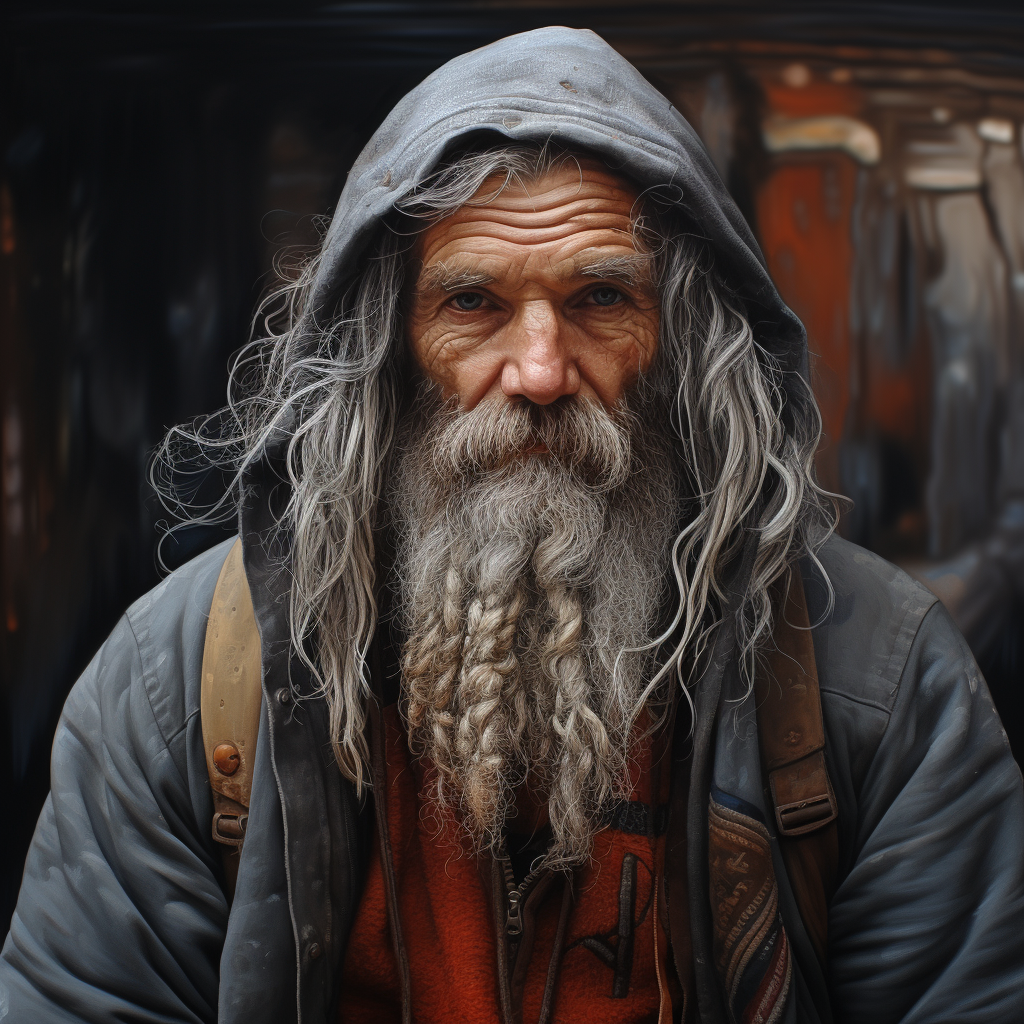Beneath the earth, a civilization sleeps and dreams a thousand years of evolution, waiting for the day when the surface world reconnects. A journey into the heart of humanity’s deepest endeavour.
The year was 2123, a time etched in the annals of human history when our species made a decision born out of equal parts audacity and necessity. Following a turbulent era of environmental chaos and an epoch of soul-searching about our fraught relationship with the planet, humanity decided to cast its lot in an entirely unexpected direction: beneath the Earth’s crust. Our collective gaze, which once sought to pierce the celestial beyond, now shifted to the unseen depths of our own world. The project, a solution crafted out of desperation and ingenuity, was conceived to be an underground city, a sanctuary in the bedrock. This subterranean refuge was named “UnderHaven”.
At the helm of this unprecedented venture was an ensemble of the brightest minds the globe had to offer. Architects whose visions had reshaped the skylines of the world’s great cities, engineers who had tamed rivers and moved mountains, geologists whose wisdom was carved from the very bones of the earth, and scientists, those relentless pursuers of truth across every field of study. They were assembled within a vast compound nestled amongst the grandeur of the Swiss Alps. Amidst the perpetual snow and jagged peaks, these pioneers began a task the likes of which had never been seen in the timeline of human endeavour.
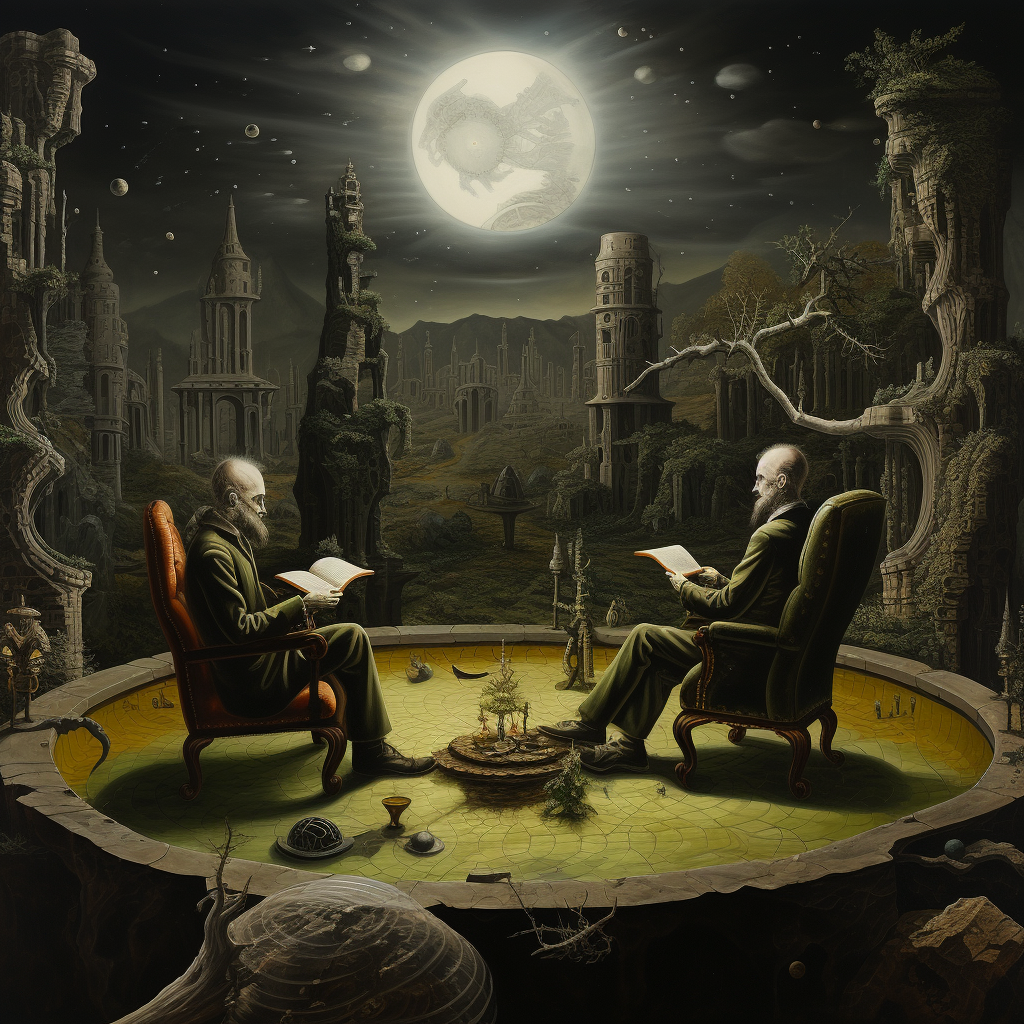
The ambition was not merely to carve out a hollow within the earth and deem it livable. The goal was to create a realm beneath the soil that held the allure of a dream, an environment that was not a compromise but a destination. UnderHaven was envisaged as a blend of comfort and advanced technology. The visionaries imagined residents wandering through artificial parks, where every leaf was caressed by the gentle glow of an artificial sun, and where the whispering breeze carried the scent of synthetic blossoms. It would be a place where the constructs of weather and time were not dictated by nature’s whims but could be modified at the touch of a button to suit the residents’ mood. In the deepest recesses of the Earth, they planned to create a version of Eden, an oasis shaped by the hand of mankind.
As the years unfurled, the idyllic tranquillity of the Swiss Alps was punctuated by the relentless symphony of progress. The mountains echoed with the orchestral hum of drills and machines, their melodies telling tales of human ambition. The dream, once just an ethereal vision, began to gain substance and solidity. In the heart of the Earth, an architectural wonder was being wrought, a city unlike any the world had ever seen.
Finally, after years of relentless effort, UnderHaven was complete. Standing as a monument to the tenacity of human spirit, it was an unparalleled feat of engineering. Its cavernous expanses were filled with the hum of advanced technology, its structures bore the elegance of superior design, and its environment teemed with artificial life. It was more than just a city; it was a testament to humanity’s resilience, to our ceaseless yearning for innovation, and our undying spark of hope for a sustainable future.
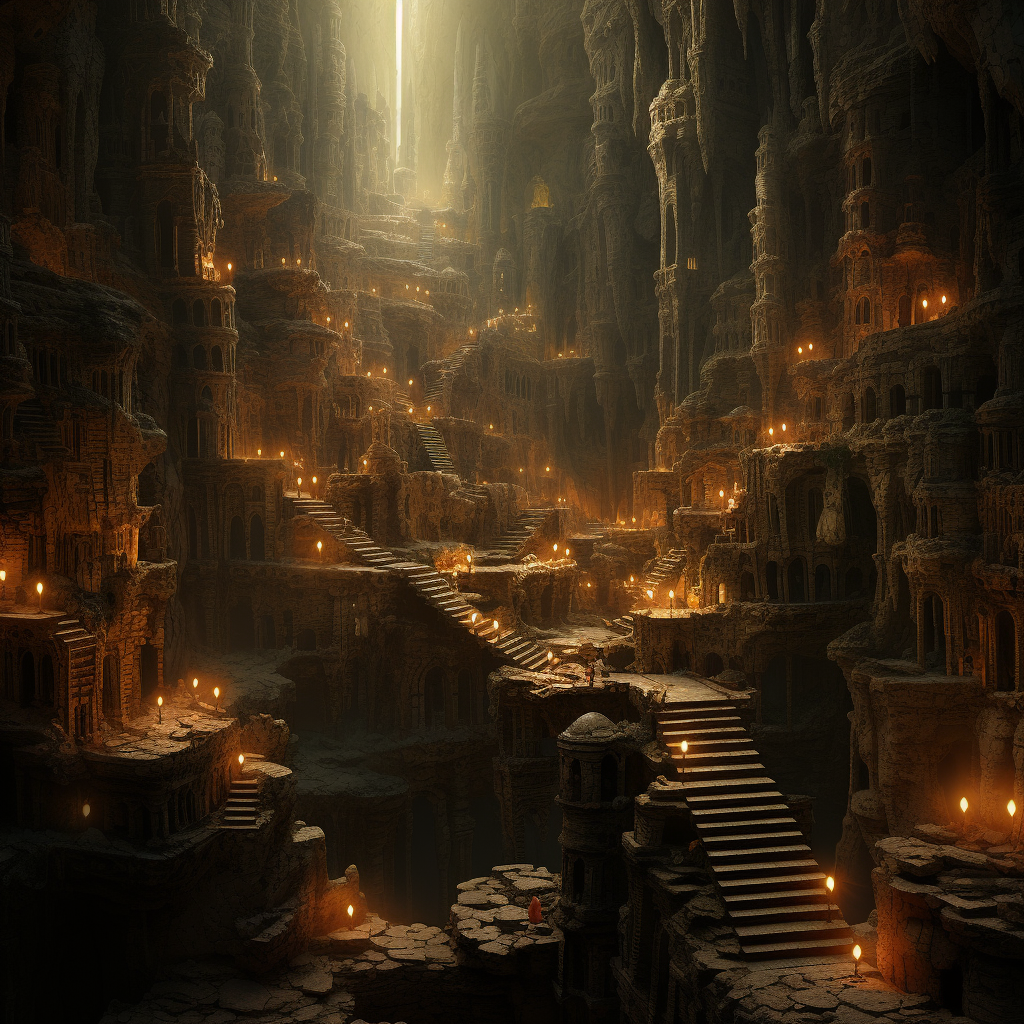
Next came the heroes of this saga, the brave ten thousand volunteers who would populate UnderHaven. They were a mosaic of humanity itself, diverse in their origins, their vocations, and their dreams. There were families yearning for a fresh start, scientists eager for the endless realm of discovery, artists seeking new inspirations, and engineers, those unspoken poets of the tangible world, all united by the shared courage to leap into this unprecedented journey. The agreement was clear: a millennium in this subterranean realm, an epoch without any contact with the world they were leaving behind.
As these pioneers descended into the heart of UnderHaven, the soft glow of the artificial sun cast an ethereal light on their expectant faces. The city, once a dream in the minds of a few, now stood ready to embrace them, its mechanical heart beating in synchrony with their own. The world above, in a rare moment of collective emotional unity, bid them farewell. It was a farewell filled with a heavy sense of longing, a solemn whisper of goodbye, and a hopeful promise of a reunion a thousand years in the making. The legacy of their courage would be etched in the annals of human history as they stepped into their new world, the door closing behind them, sealing their date with destiny.
As the ten thousand volunteers descended into the depths of UnderHaven, the hum of excited whispers filled the cavernous expanse. Among them, a young woman, Lily, a scientist eager to study the underground ecosystem, turned to her companion, an elderly artist named Samuel, her eyes shimmering with anticipation.
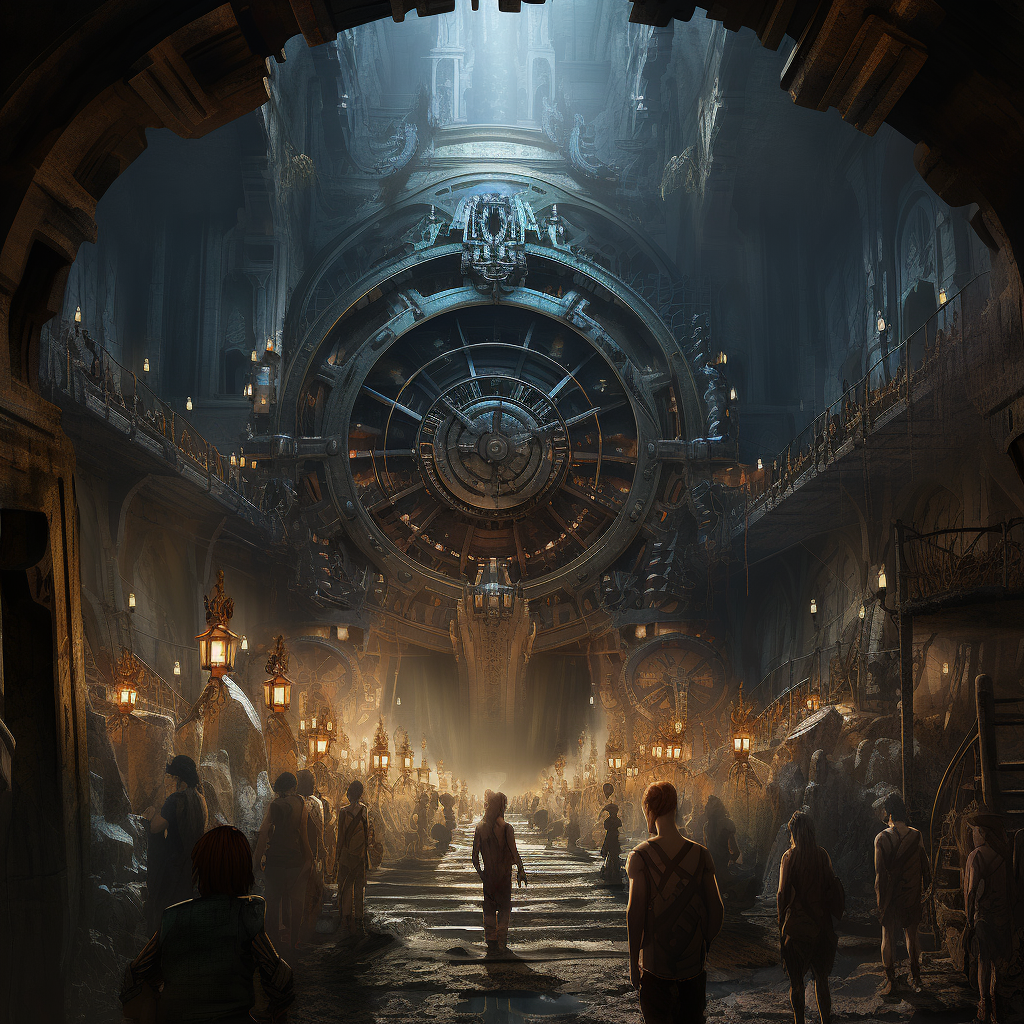
“Do you feel it, Sam?” she asked, her voice shaking slightly. “It’s as if we’re stepping into a completely new era.”
Samuel gave her a gentle smile, his eyes reflecting the synthetic sunlight. “Indeed, Lily,” he replied, his voice brimming with a calm excitement. “This is more than just a city. It’s a canvas, a clean slate. Who knows what we might paint here.”
Elsewhere, a family huddled together, their young daughter, Ava, gazing around in wide-eyed wonder. “Mummy,” she whispered, tugging at her mother’s hand. “Will we see the stars from down here?”
Her mother, Hannah, a stout woman with kind eyes, knelt down, her hands resting on Ava’s shoulders. “No, sweetheart, we won’t see the stars like before,” she said gently. “But we’ll have a whole new sky to discover. And who knows, we might find things even more beautiful than the stars.”
On the surface, people across the globe watched the historic descent in captivated silence, their eyes glued to televisions and mobile devices. In a small pub in London, an old man, George, clutched his pint and mumbled to his friend, “Never thought I’d live to see the day humans burrowed like rabbits.”
His friend, Maggie, a woman of comparable age with sharp eyes, chuckled lightly. “Oh, stop your grumbling, George. It’s amazing. They’re making history, they are.”
Meanwhile, in a bustling café in Mumbai, a young woman, Priya, watched the live broadcast on her mobile device. Her friend Ravi joined her, his eyes widening as he saw the screen. “They’re really doing it, aren’t they? A thousand years without any contact. I can’t even imagine.”
Priya nodded, her eyes reflecting the artificial sunlight illuminating the underground city. “It’s like a new age odyssey, Ravi. It’s scary, but at the same time, it’s such a testament to human courage. Makes you wonder about the stories we’ll hear when they re-emerge a thousand years from now.”
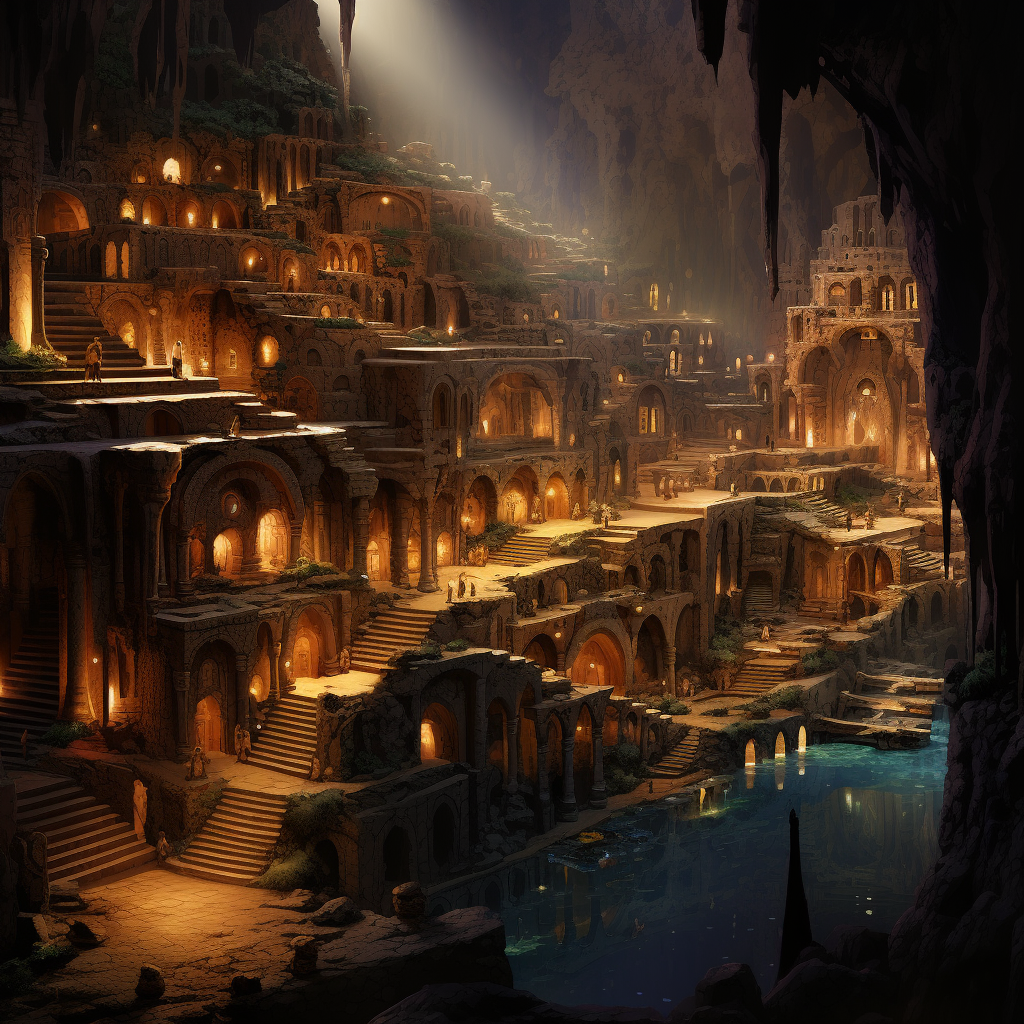
Across the world, as people watched their fellow humans descend into a new world, they echoed similar sentiments of awe, apprehension, and an enduring sense of hope. History was being written, and they were the privileged audience.
As the last of the volunteers disappeared into the heart of UnderHaven, a hush fell over the crowd still lingering on the surface. All eyes were on the solitary figure standing on the precipice of this extraordinary journey. He was the final emissary of the surface world, a middle-aged engineer named Thomas who had spent the better part of his life dreaming, designing, and now delivering UnderHaven.
The cool alpine wind swirled around him, as if the earth was whispering its farewells. His eyes swept over the sea of faces, engineers and scientists who had dedicated their lives to this incredible project. Among them was Marianne, a brilliant geologist whose guidance had been invaluable. He locked eyes with her, a mutual understanding passing between them, their silent goodbyes resonating louder than any words could.
Taking a deep breath, Thomas turned towards the vast opening that led to UnderHaven. As he stepped onto the platform that would carry him down, his heart pounded with a mixture of exhilaration and melancholy. He allowed himself one last look at the sky, the wide expanse of blue dappled with white clouds. He inhaled the cool mountain air, the scent of pine and distant snow. Then, with a nod to Marianne and the others, he signaled his readiness.
The platform began to descend, its mechanical hum echoing in the cavernous expanse of the entrance. Thomas, the last earth-born resident of UnderHaven, disappeared into the artificial sunlight, his silhouette shrinking until it was no more than a speck against the radiant glow.
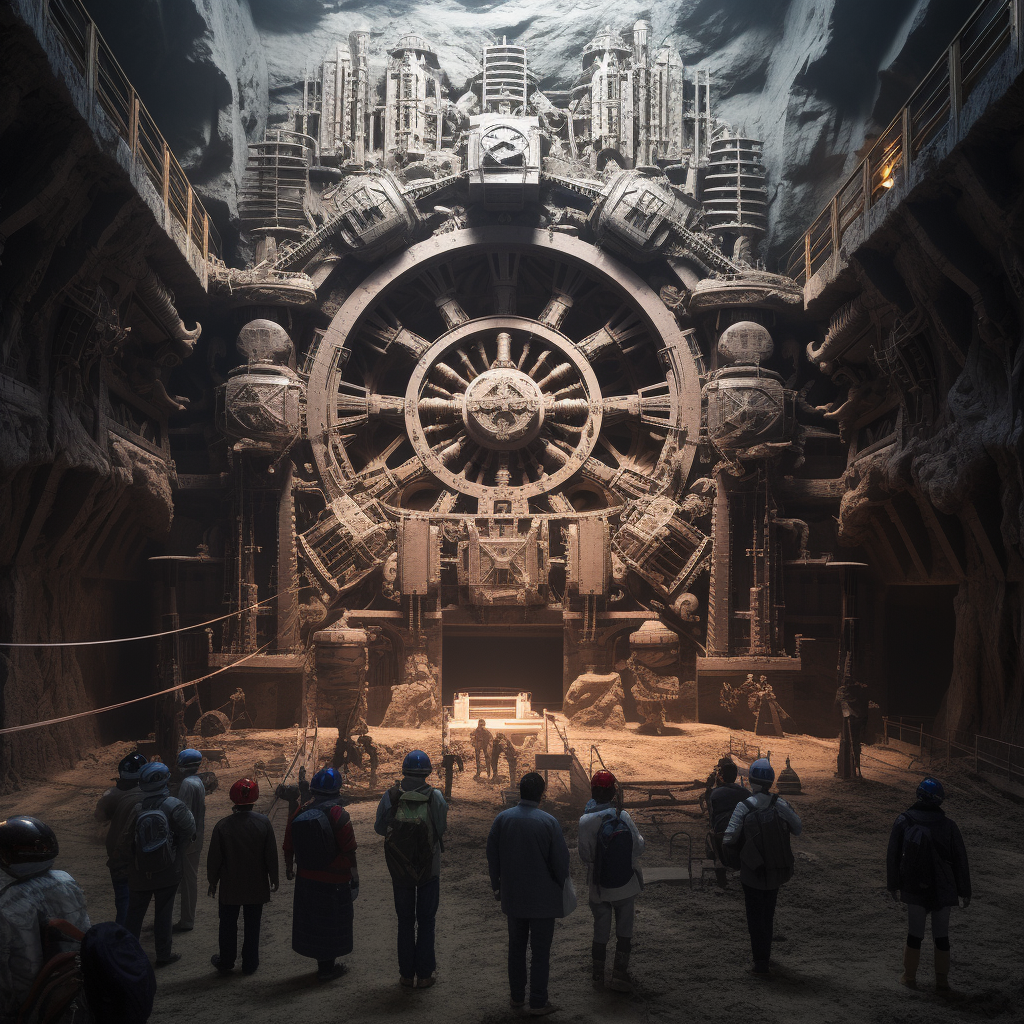
Above, Marianne moved towards the colossal control panel, her heart heavy but resolved. She glanced around at her team, their faces echoing her own emotions. Their years of toil, the challenges they’d overcome, were all leading to this singular moment. With a deep breath, she activated the command sequence for the gargantuan gate.
The earth trembled as the massive gate began its descent, each second closing off UnderHaven a little more from the surface world. The sheer enormity of the steel leviathan was awe-inspiring, its weight borne by massive hydraulics and countless hours of human endeavour. It moved with a grace that belied its colossal size, sealing UnderHaven off bit by bit.
When the final echo of the closing gate died away, a silence descended. All that was left was the imprint of the gate on the landscape, a testament to the ten thousand souls who had taken the first steps into a new era for humanity. UnderHaven was now a time capsule, its heartbeat silenced for the world above but alive and vibrant for those within. The farewell was complete; the wait for a millennium had begun.
As the echoes of the closing gate died away, time unfurled on the surface. A thousand years spun their endless dance, weaving a complex tapestry of human existence. Humanity wrestled with its challenges and celebrated its triumphs, its narrative of survival etched across the centuries. The contours of political landscapes shifted like sand dunes under the winds of change. Empires rose, their might echoing across the globe, only to fall and be swept into the annals of history, their once resounding roars now hushed whispers of a time long past.
The Earth, that enduring canvas of life, continued its celestial waltz. The climate, once teetering on the brink of disaster, found its equilibrium. Yet, it was not to last. Periods of stability gave way to epochs of tumultuous change, the pendulum of climatic conditions swinging with the inexorable march of time. But the resilience of the planet prevailed, as it regained its balance once again. The air grew cleaner, the seas healthier, the forests reclaimed their ancient territories. The scars of past transgressions healed, even as new ones were inflicted.

Technological advancements bounded forth in leaps that would have left the architects of UnderHaven astounded. Artificial intelligence became a seamless part of life, indistinguishable from human interaction. Space, the final frontier, was no longer final. Colonies on Mars, mining operations on asteroids, and voyages to the outer solar system became a reality. Technologies beyond the wildest imaginations of those who had bid farewell to UnderHaven were brought to life. Yet, they remained a mere glimpse of the human potential, a testament to our innate desire to push beyond the realms of the possible.
But amidst the ebb and flow of centuries, one promise was unwavering, a thread of continuity running through the fabric of time. It was a commitment handed down through generations, a pledge whispered from parent to child, teacher to student, leader to citizen. The promise was to remember, to honour the pact made a millennium ago, to reconnect with the city buried beneath the earth and its brave inhabitants. The lore of UnderHaven was etched in the collective consciousness of humanity, a mythical tale grounded in reality. The anticipation built over the centuries, a crescendo that would soon reach its peak. The reunion, after a millennium of silence, was imminent.
Twenty years before the destined reunion, an undercurrent of debate began to swirl around the world. The impending opening of UnderHaven stirred a plethora of questions, conjectures, and controversies. The world had changed in a thousand years, and many wondered if the buried city should remain an undisturbed time capsule.
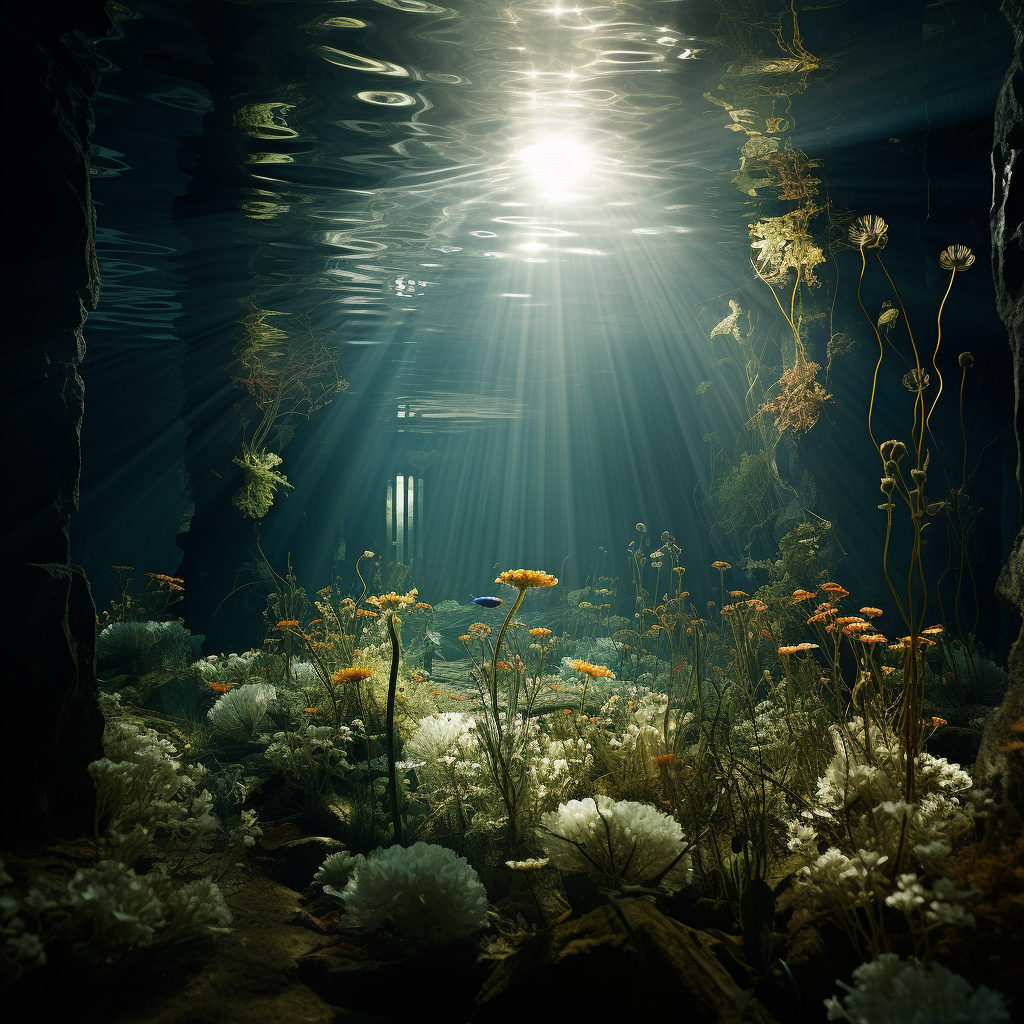
“Should we open UnderHaven?” This question echoed in town squares, in the chambers of global forums, and across countless virtual debates. Some believed that it was better to let the past lie undisturbed, that the brave pioneers of UnderHaven should rest in their subterranean haven, unmarred by the advancements and challenges of the surface world.
Pessimists and sceptics hypothesized about the potential nonexistence of a civilisation within UnderHaven. They suggested that perhaps, the residents had not survived the millennium underground, painting grim pictures of a tomb rather than a thriving city beneath the Earth.
Bioethicists and scientists raised another pressing concern – the danger of lethal pathogens. They warned of unknown viruses or bacteria that might have evolved in the isolated environment of UnderHaven, potential pandemics locked beneath the surface. Such organisms could wreak havoc on the surface world, unprepared for the unfamiliar biothreats. Conversely, they also highlighted the danger to UnderHaven’s inhabitants who might not have the immunity to combat diseases prevalent in the surface world. A reunion might spell a death sentence for the dwellers of the underground city.
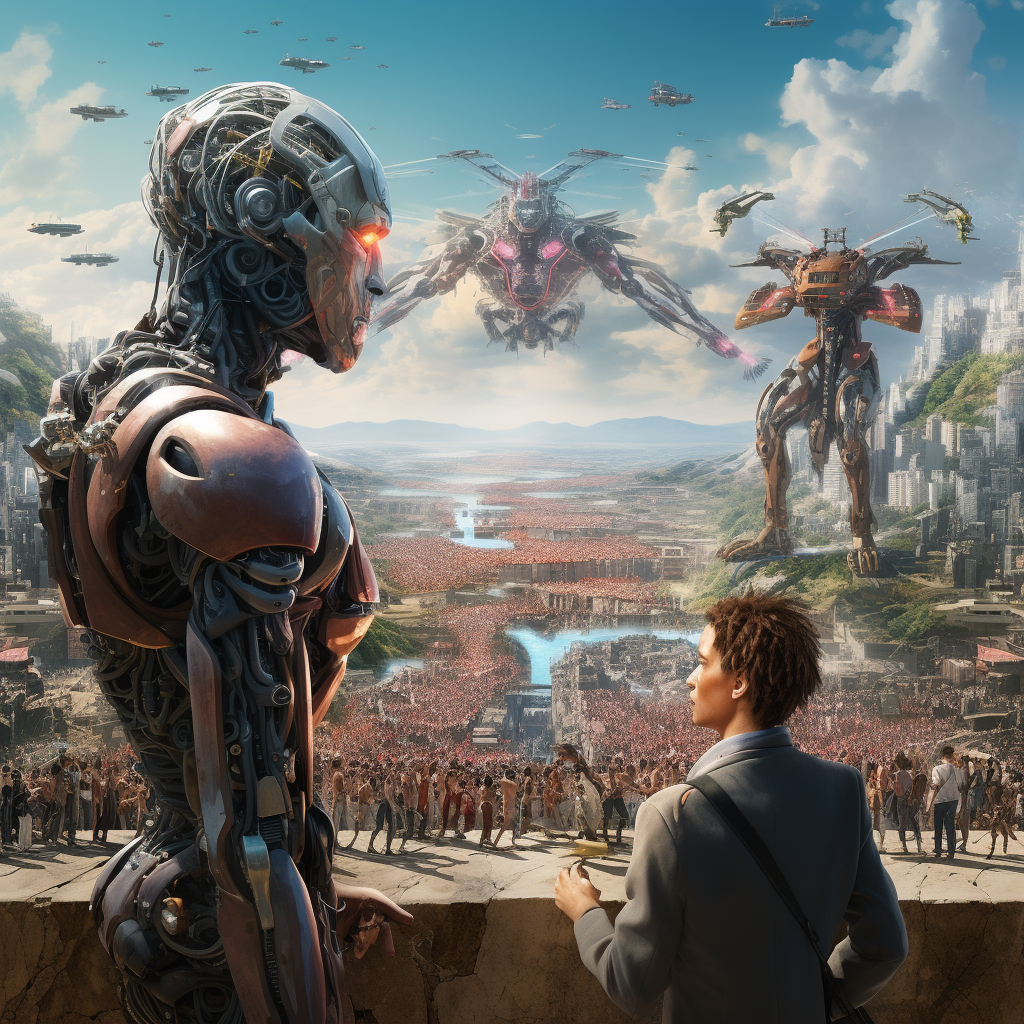
Religious leaders and philosophers pondered the impact on societal structures. They speculated about the nature of religion and belief systems that might have evolved in isolation within UnderHaven. The potential clash of ideologies and the possible upheaval this could cause in an already fragmented world were worrisome.
Anthropologists and linguists wondered about the language that the UnderHaven dwellers would have evolved. A thousand years of linguistic drift could have resulted in a language completely alien to the surface world, potentially creating a significant communication barrier.
Economists and politicians debated the geopolitical implications. The opening of UnderHaven could shift power dynamics, potentially leading to conflicts over the ownership and control of the city and its technology. The underground city could become a political pawn, leading to global tensions.
As the debate raged on, the countdown to the millennial reunion continued. The promise made a thousand years ago was approaching its due date, and humanity grappled with the possibilities of what lay beneath.
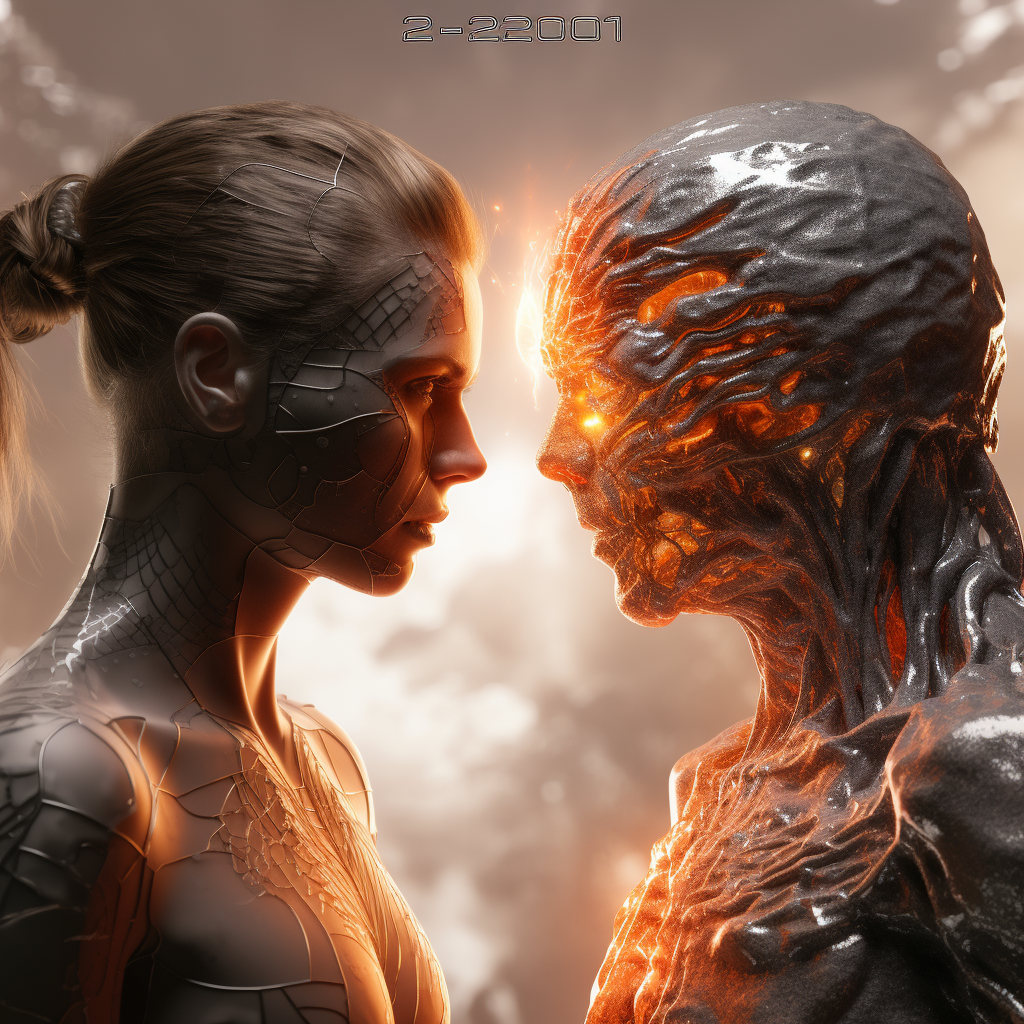
Despite the whirlwind of debates and discussions, the consensus eventually leaned towards the opening of UnderHaven. The gravitational pull of the promise made a thousand years ago was too potent to resist. The prospect of discovering the fate of the ten thousand brave volunteers, the allure of a unique society evolved in isolation, and the potential for unprecedented scientific and historical insights were compelling arguments that tipped the scale.
The decision was not made lightly. It was the culmination of extensive deliberations, considerations of all the potential risks and rewards. It was, after all, a monumental moment, the unearthing of a thousand-year-old time capsule. It was agreed that all necessary precautions would be undertaken to safeguard both the surface and underground populations against potential biothreats. Linguists began developing translation algorithms, using historical data and predictive models to bridge any potential language gaps. Diplomatic protocols were put in place to manage geopolitical ramifications.
So, the world held its breath as the countdown to the opening of UnderHaven continued. The sense of anticipation was palpable, spreading across nations and generations, echoing the excitement and anxiety that had pervaded the world a millennium ago. After a thousand years, humanity was once again on the brink of a new era.
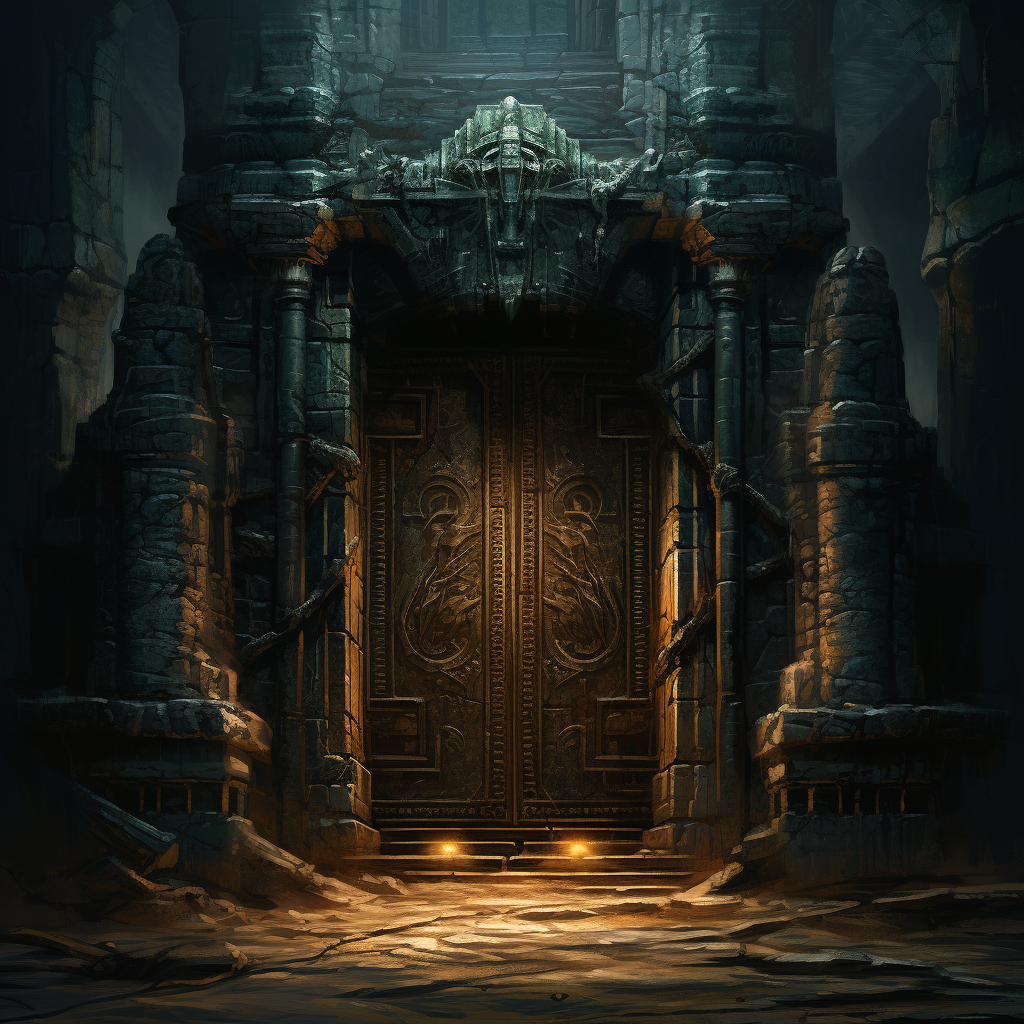
Finally, the day arrived. The day that had been a thousand years in the making dawned bright and clear. At the foot of the ancient access point to UnderHaven, a team of explorers had gathered, each one selected for their unique expertise and their courage. This group was the embodiment of a millennium of progress, equipped with technology that made the science of their ancestors look primitive.
As they prepared to descend, the tension among them was palpable. “Are we all ready then?” asked Commander Abigail Reynolds, her voice echoing off the stone walls. She was a veteran astronaut, chosen for her experience in handling the unknown. Around her, the team nodded, their faces a mix of anticipation, excitement, and anxiety.
At her signal, the enormous doors that had been sealed for a millennium began to shift. The groan of metal against stone was deafening, echoing into the silence that had enveloped this place for a thousand years. Then, the doors were open, and before them lay the city of UnderHaven, bathed in an otherworldly twilight.
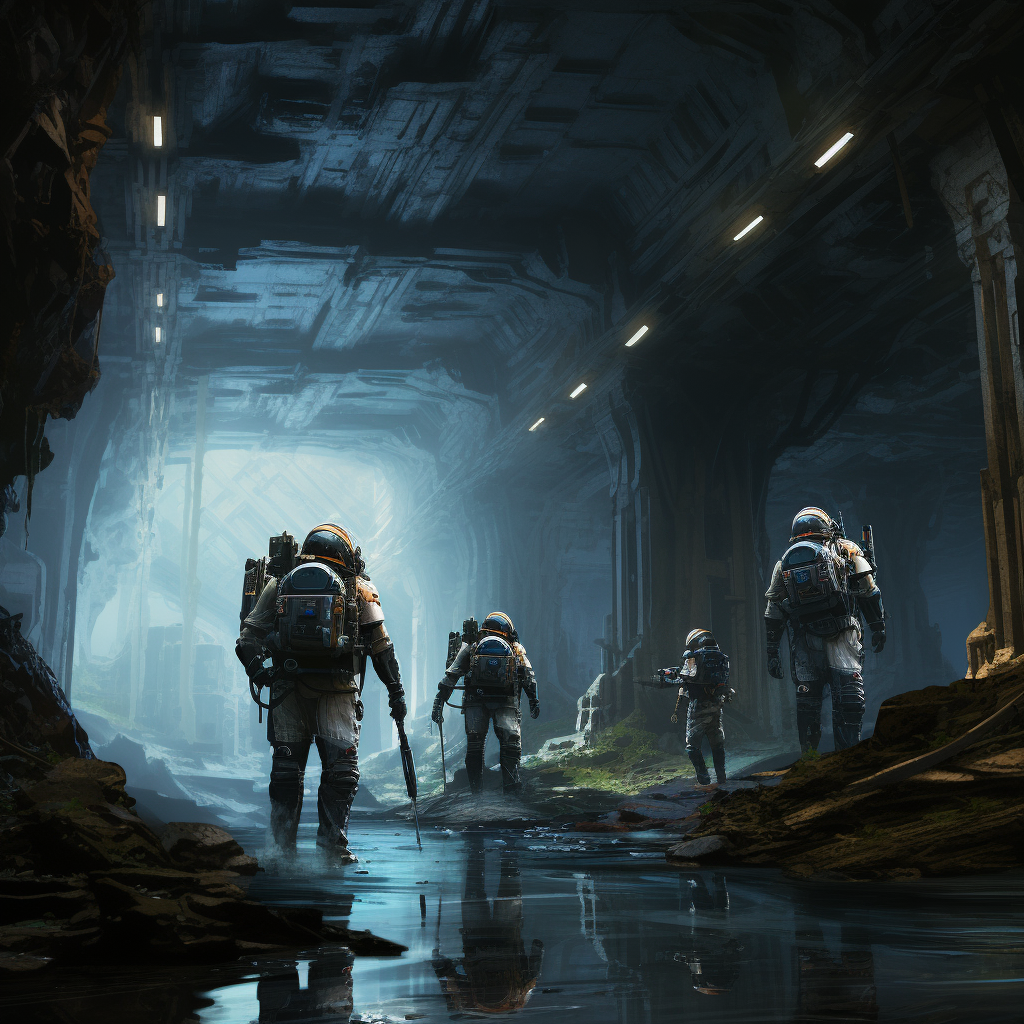
The explorers had anticipated a city humming with advanced technology, alive with the hustle and bustle of a thriving civilisation. Yet, what greeted them was an eerie tranquillity. It was as if the city was caught between slumber and wakefulness, a dream-like reality that none had envisioned.
“Isn’t it…quiet?” voiced Dr. James Kibwe, a renowned linguist, his eyes scanning the expansive cityscape. “It’s unsettling.”
“We knew we were stepping into the unknown, James,” Abigail replied, her gaze steady on the path before them. “Let’s press on.”
As they delved deeper into the city, they made an astonishing discovery. There were people – the descendants of the original ten thousand. They moved through the city with a grace that spoke of a deep connection to their environment. But the city around them was vastly different from the high-tech wonder it was meant to be. Instead of advanced machinery, there was a harmony of natural and built environments, a far cry from the original vision of UnderHaven.
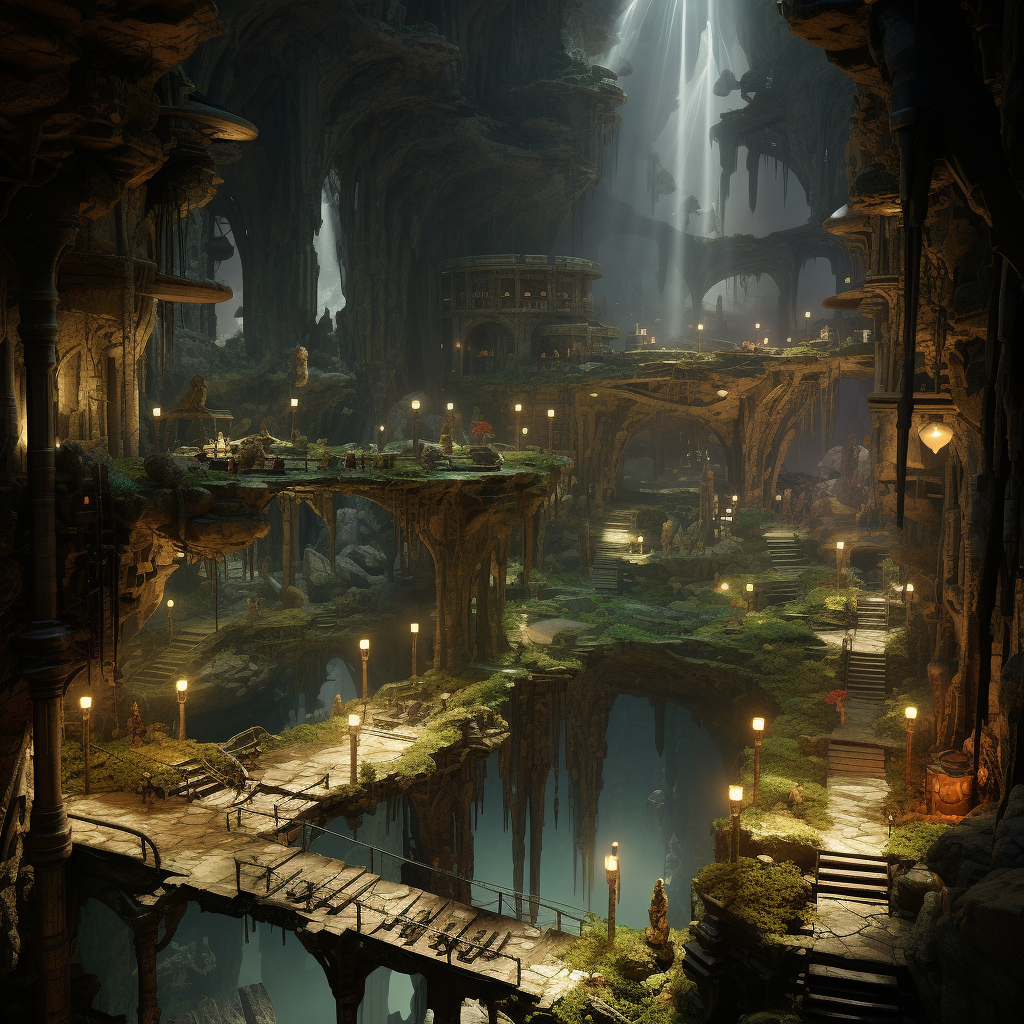
As the explorers watched in awe, Abigail turned to her team. “Welcome to UnderHaven,” she said, her voice barely above a whisper. “Let’s find out their story.”
UnderHaven was not merely an underground city; it was a living, breathing testament to human adaptability. The originally cold, metallic buildings were now entwined with emerald green vines, softening their austere angles and infusing them with a vibrant vitality. Crystal-clear waterways replaced the concrete streets, meandering through the city in a mesmerising dance. The soft glow of the artificial sunlight was gentler than the surface team had anticipated, nurturing an astonishing array of plant life that had made UnderHaven their home.
This was a world where technology hadn’t been forsaken, but rather reshaped and reimagined. The inhabitants of UnderHaven had taken the machines and concepts of their ancestors and woven them into the very fabric of their lives. They had married the inorganic and the organic in a profound partnership, creating a society that was a perfect symbiosis of nature and human invention.
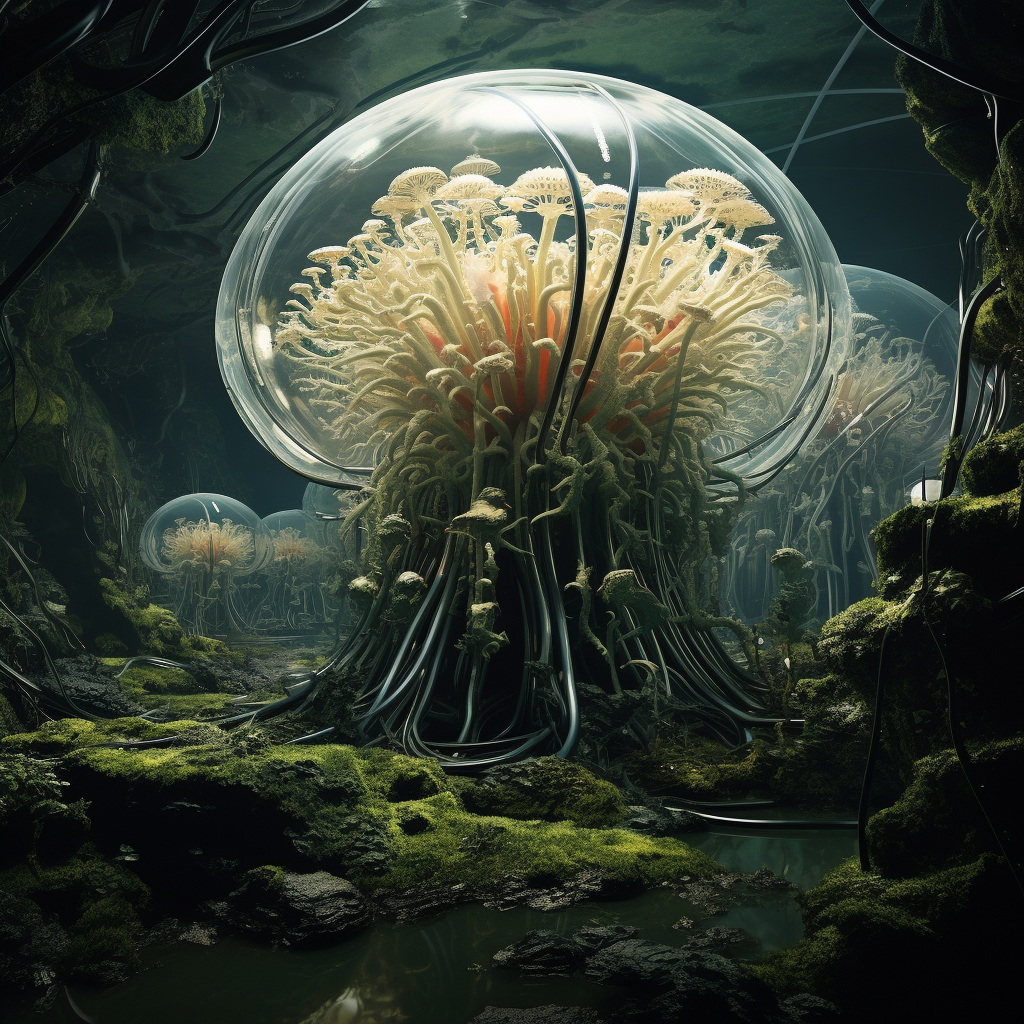
The explorers’ first encounter with the inhabitants of UnderHaven was electric with tension. The surface team was met with eyes filled with cautious curiosity, gazes that were as evaluating as they were welcoming. The chasm of a thousand years of separate evolution yawned wide between them, yet the thread of shared ancestry provided a bridge.
One of the inhabitants stepped forward, a woman with an air of quiet authority. “Welcome, surface dwellers,” she greeted, her voice carrying through the silent city. Her words were familiar, yet carried the cadence of a language that was an amalgamation of many – a testament to a millennium of unified evolution within the confines of UnderHaven.
Dr. Kibwe, after a moment of stunned silence, replied in kind. “Thank you for your welcome,” he said, his tone respectful. Despite the differences, the underlying spirit of humanity was unmistakable. They were all descendants of the same ancestors, bound by the invisible threads of shared history and heritage. This was merely the beginning of a new chapter in their intertwined narratives.
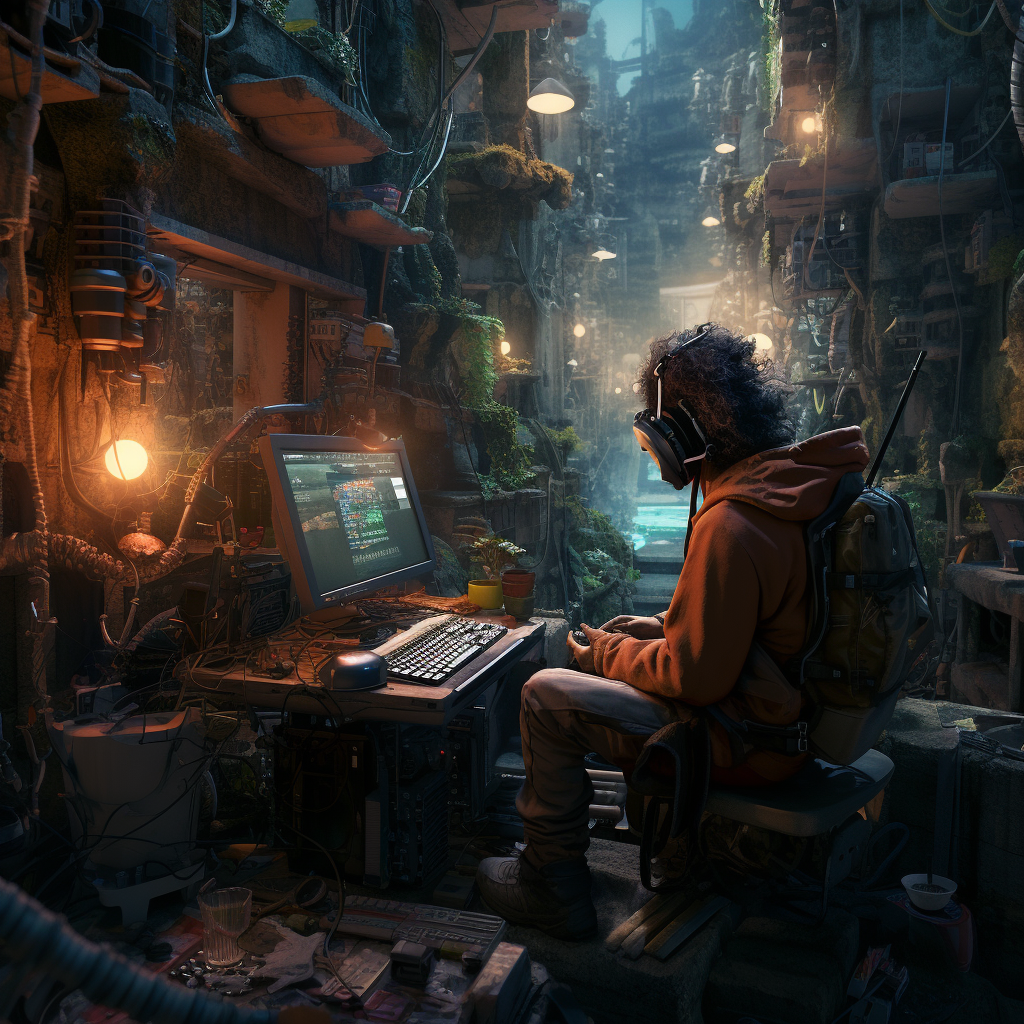
As the explorers ventured deeper into UnderHaven, they came across a group of inhabitants engaged in what appeared to be a lively discussion. The surface team approached cautiously, noting how the UnderHaven dwellers paused their conversation to watch the newcomers with curious eyes.
“Hello,” Commander Reynolds began, her tone friendly but assertive. “We come in peace from the surface. We mean you no harm.”
The group shared a glance before a man with a kind smile stepped forward. “We understand,” he said. “And we’ve been expecting you. It’s been foretold in our legends.”
There was a sense of camaraderie in his words that put the explorers at ease. They spent some time exchanging basic information, learning about each other’s way of life. The residents of UnderHaven seemed to have retained knowledge of the surface, passed down as tales and legends over the centuries.
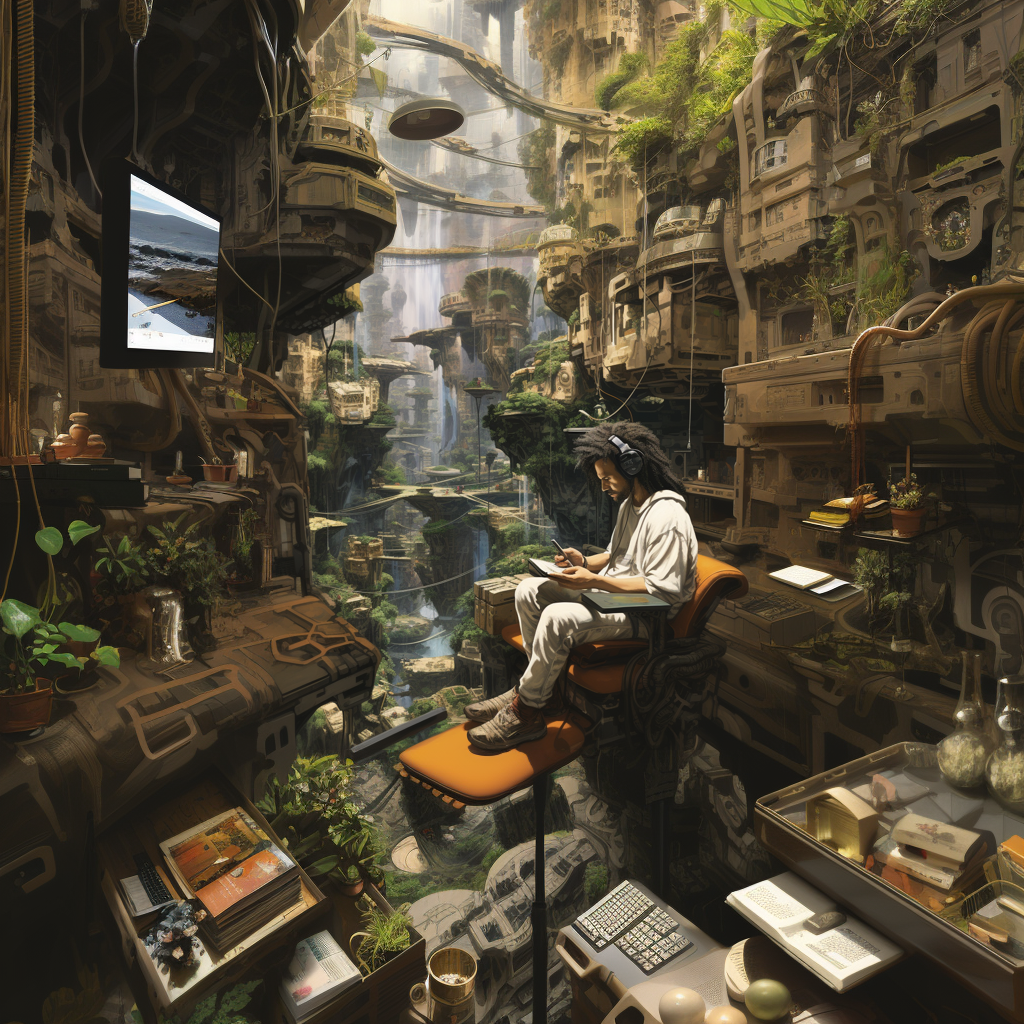
After a while, the man who had first responded gestured towards one of the grand buildings that loomed nearby. “Our leader would like to meet you. Come, we’ll take you to him.”
The explorers shared glances. They hadn’t anticipated a singular leader. UnderHaven had been designed to be a democracy, with systems in place to ensure equal representation.
As they were led through the winding waterways and lush greenery, they arrived at a grand structure, far more intricate than the others. They were escorted inside, into a great hall where a man sat upon a throne-like seat, looking every bit a monarch. His bearing radiated authority, and it was clear he held the respect of his people.
“Welcome to UnderHaven, surface dwellers,” he greeted them, his voice carrying the weight of the millennium. “I am King Eamon, the leader of these people.”
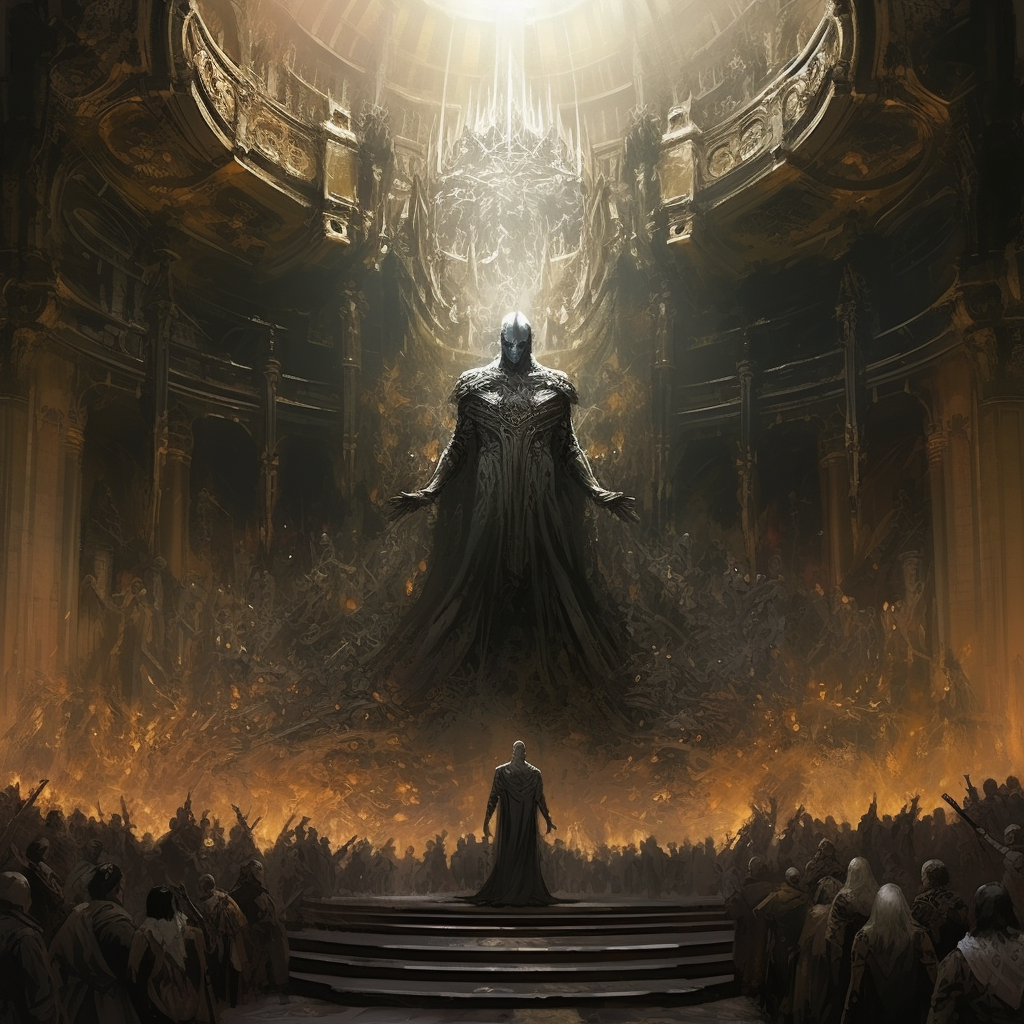
For a moment, the explorers were stunned into silence. They had discovered not only an underground city but an entirely new kingdom. The democracy they had expected was instead a monarchy, yet the people appeared content, living in harmony with their environment and their leader. They were not just revisiting the past, but rather unearthing a parallel evolution of human society.
The reunion was a poignant reminder of how far humanity had come, and the unfathomable possibilities that lay in its future. The people of UnderHaven had not merely survived; they had thrived, crafting a civilisation that struck a delicate, yet enduring, balance between human ingenuity and the nature that surrounded and sustained them. They had taken the bones of the city given to them and grown a living, breathing testament to adaptation and unity.
In their yearning to recreate the world they had left behind, the ancestors of UnderHaven had birthed a unique culture. The arts flourished, with the city’s walls adorned with luminous frescoes depicting their history and mythology. They developed music that echoed the rhythm of their environment, serene and resonating with a deep sense of connection. Their scientific advancements leaned heavily on symbiosis with nature, evident in their methods of food production, transportation, and energy generation.
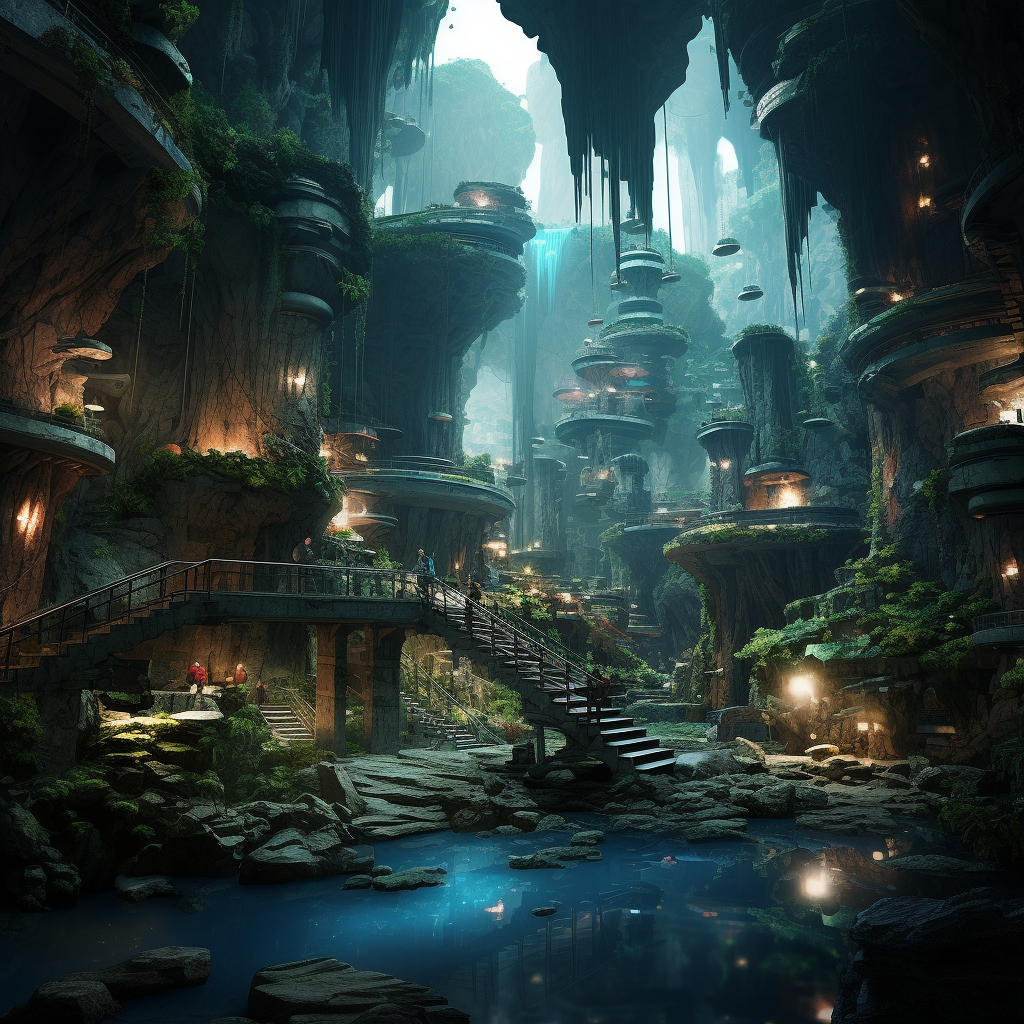
The surface people were awestruck. They had expected to encounter a society held in a time capsule, not one that had diverged and developed in such remarkable ways. The inhabitants of UnderHaven had taken a planned and clinical environment and turned it into a thriving biome that worked in harmony with the technology of its founders.
While the initial shock of discovering a kingdom within UnderHaven took some time to process, the surface dwellers soon realised that the age-old pact between their ancestors and the original inhabitants had made no stipulations about the nature of their interaction post-reconnection. This was uncharted territory, ripe with opportunities for mutual learning and growth.
The dialogue between the two societies began tentatively. It was a dance of diplomatic niceties and curiosity-driven questions, gradually growing into a genuine exchange of ideas and information. The surface dwellers were fascinated by the seamless integration of technology and nature in UnderHaven, and the harmony in which the inhabitants lived with their surroundings.
“Your technology, it’s…beautiful,” Dr. Elizabeth Chen, the surface team’s leading biotechnologist, admitted to one of UnderHaven’s scientists. “You’ve managed to create something that doesn’t merely coexist with nature, but is a part of it.”
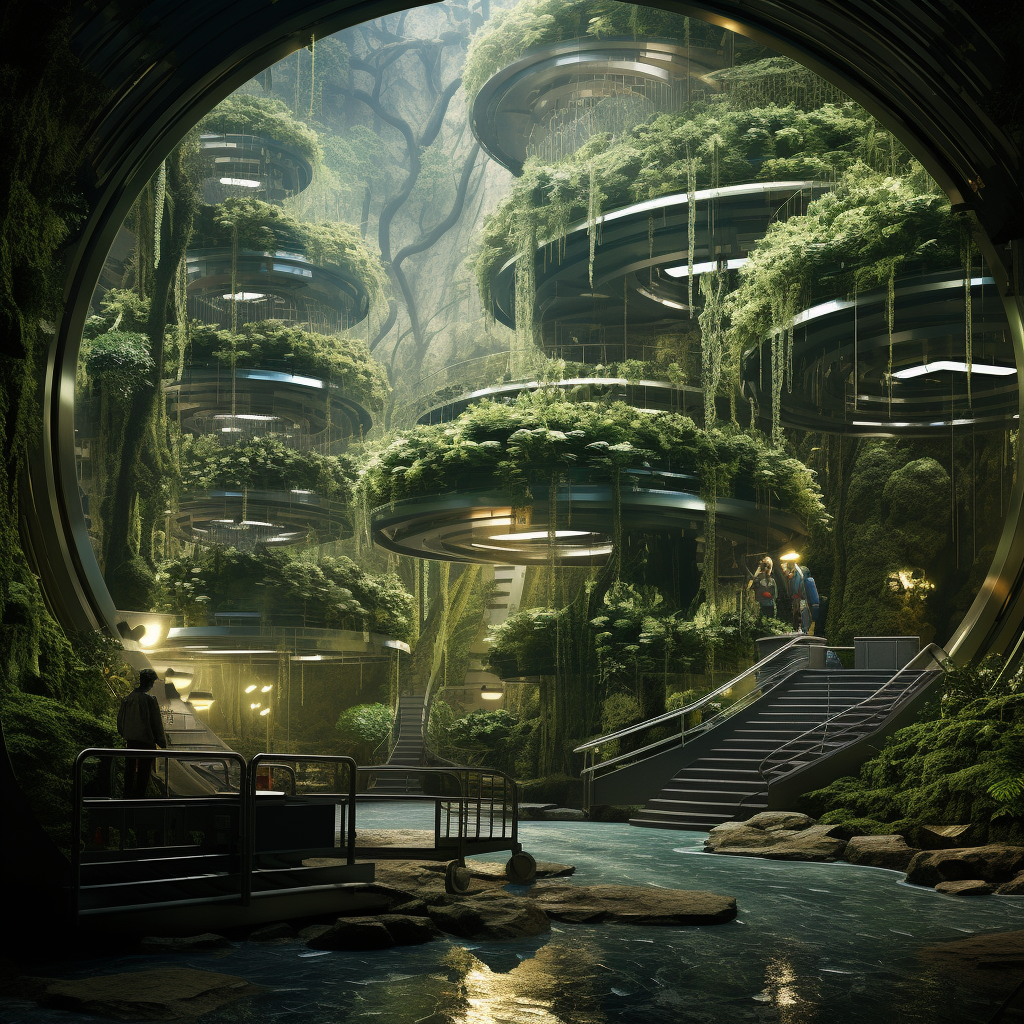
“And your societal structure, it’s so different, yet it works,” added Commander Reynolds, her gaze on King Eamon, who listened with a humble smile. “How did this transformation occur?”
“It evolved with us,” replied King Eamon, his voice calm. “As we adapted to life underground, our societal norms, our perspectives, they changed. We realised the importance of unity and mutual respect, not just among ourselves, but with our environment as well.”
UnderHaven’s advancements in bio-technology were astounding. They had managed to fine-tune the balance between preserving the natural ecosystem while incorporating technology to enhance their lives. Their societal structures were intriguing, hinting at a level of maturity and unity that many surface societies still struggled to achieve.
Their philosophy, too, was a revelation. The concept of interconnectedness, of viewing themselves as an integral part of the ecosystem rather than rulers over it, was a paradigm shift that intrigued the surface society. It presented a radically different perspective, a fresh approach towards life and technology. It was clear that this was just the beginning of an enlightening journey of shared learning and mutual respect.
Over time, a fusion of surface and underground cultures began to emerge. Exchange programmes were established, students and researchers eager to learn the strengths of the other’s society. UnderHavenians were fascinated by the stars and the endless universe that the surface people had been exploring. Similarly, the surface dwellers were taken aback by the sustainable technologies and the tranquillity that the people of UnderHaven had cultivated over a millennium.
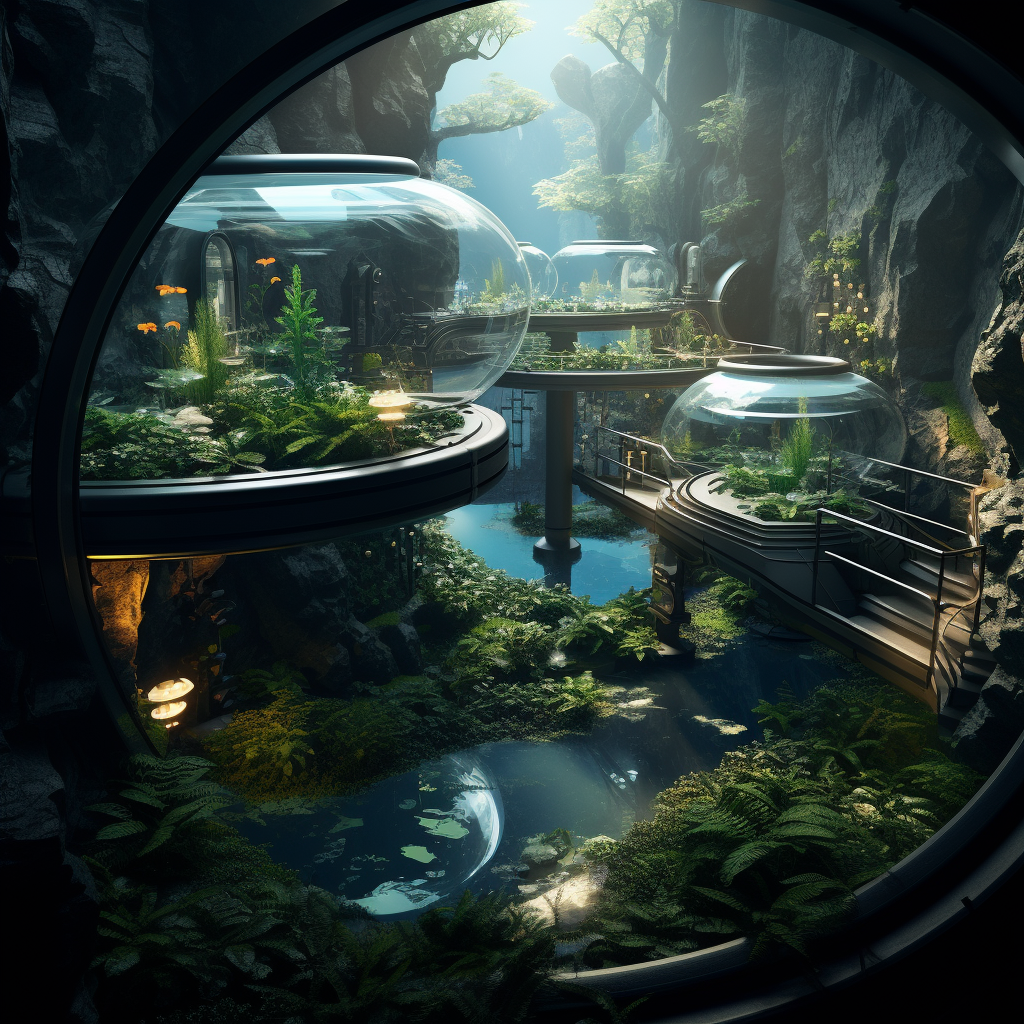
It was a meeting of minds and cultures, the past with the present, the surface with the underground. It was the dawning of a new era, a blend of histories and visions, all melded together to form a united human civilisation. It was a testament to humanity’s innate ability to adapt and innovate. Above all, it was a solemn reminder of the strength and spirit of the human race: its ability to survive, thrive and unify in the face of the unknown.
With the initial flurry of discovery and reunion subsiding, both societies began to delve deeper into their distinct evolutions. Aspects of culture, language, and religion were thoroughly explored, revealing stark contrasts and surprising parallels between the two societies.
On the surface, traditional religious beliefs had been gradually replaced by a fascination with technology and artificial intelligence. The religions that had existed before the establishment of UnderHaven had given way to new systems of belief centred around technological advancements and the exploration of the cosmos.
These tech-based religions saw AIs not as creations, but as co-travellers on the journey of understanding existence. Some revered AI as an ultimate form of life, perfected and unburdened by organic frailties, while others sought a spiritual connection with the universe through the limitless exploration enabled by technology.
Underneath, in the warm glow of the subterranean city, an entirely different spiritual landscape had emerged. Cut off from the rest of the world, the people of UnderHaven had developed their religions that drew heavily from the unique conditions of their environment.
Their beliefs were imbued with a deep respect and reverence for the balance they had struck between technology and nature. Many saw the Earth as a living, conscious entity, with themselves as parts of a larger organism. Others worshipped the ancient technology left by their ancestors, attributing to it a divine status for having sustained them for a thousand years.
Language too had diverged significantly over the thousand-year gap. The surface world, in its constant contact with different cultures and alien life forms they had discovered, developed a blend of languages, known as ‘Terralingua’, a meld of Earth’s most popular tongues, designed for simplicity and universality.
The people of UnderHaven, in their isolation, had evolved a language that was heavily influenced by their environment and daily life. It was a melodic tongue, enriched by the many sounds of their unique habitat, the hum of machines, the flow of underground rivers, the rustle of subterranean flora.
As for culture, both societies had experienced radical shifts. The surface world, with its emphasis on technology, had developed a culture that celebrated constant innovation and exploration. Art, music, and literature often reflected the vastness of the cosmos and humanity’s place within it.
The culture in UnderHaven, on the other hand, emphasised balance and harmony. Artistic expressions were deeply tied to their surroundings, and their music held echoes of the natural rhythms around them. Their literature was filled with tales of their ancestors’ bravery, stories of adaptation, and the rich mythology they had spun around their life underground.
As the societies learned from one another, there was a sense of mutual fascination and respect. While their paths had diverged significantly over the centuries, they still held the common thread of humanity. Now, brought together once more, they had a wealth of knowledge, experience, and culture to share and learn. As they delved deeper into their shared history and divergent evolutions, they found that together, they held a stronger, more diverse understanding of what it meant to be human.
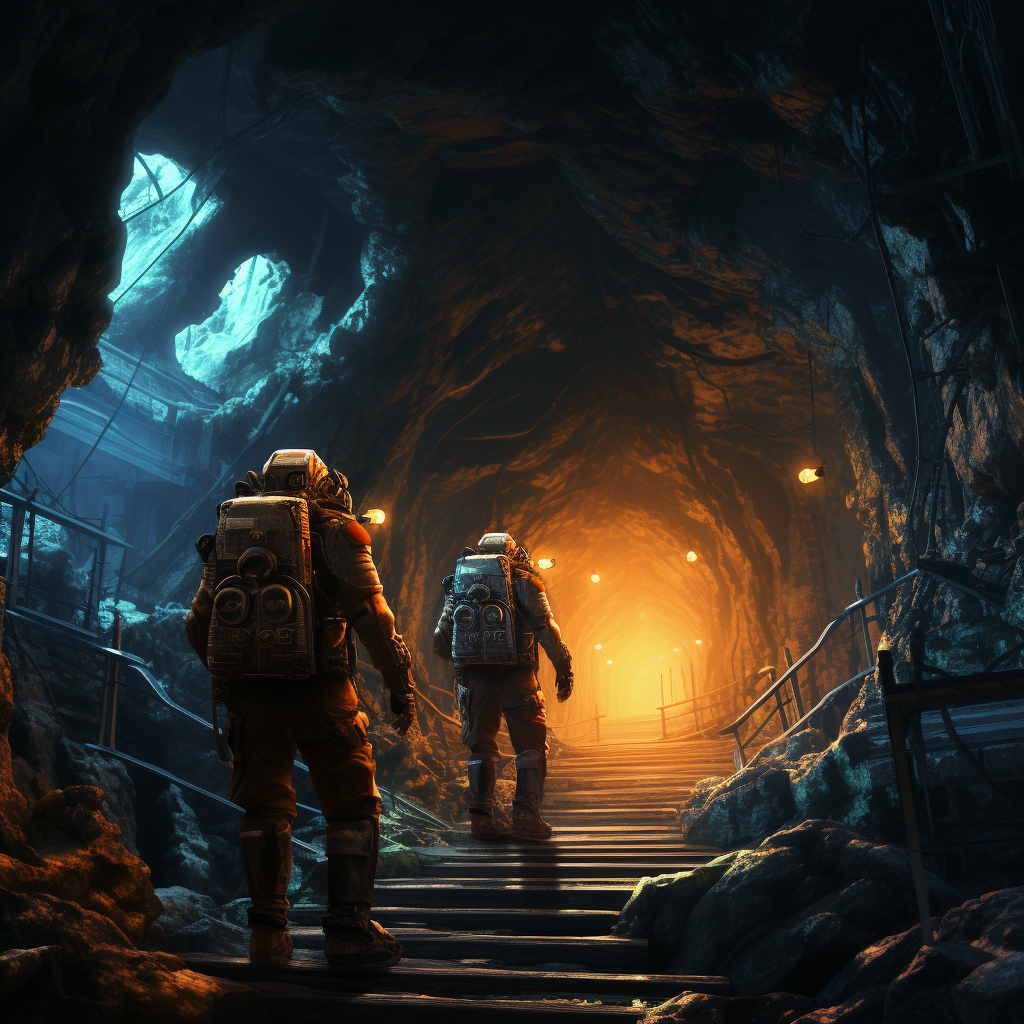
All images generated using Midjourney
